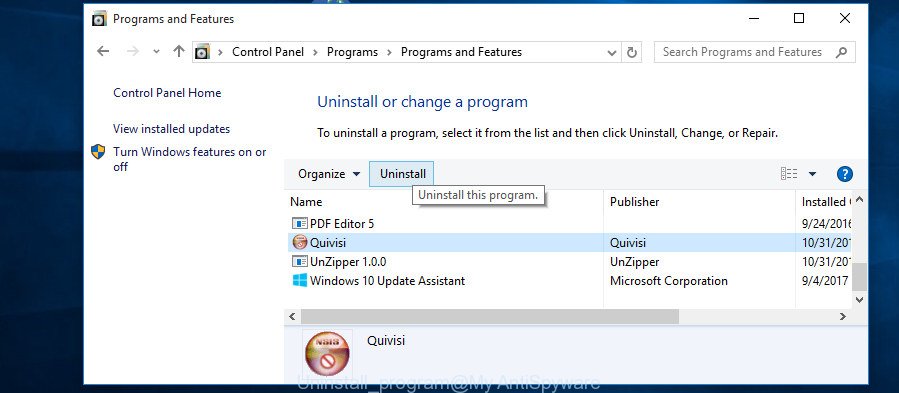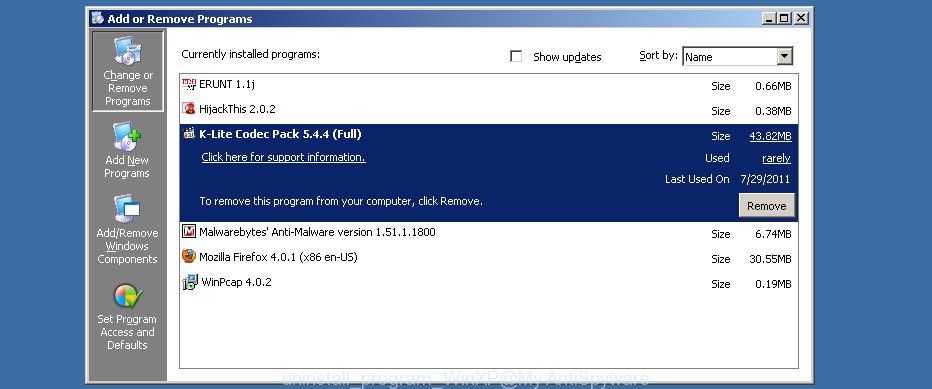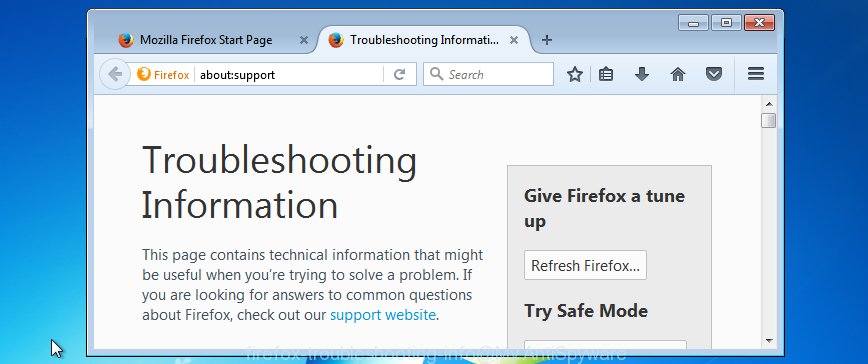What is Weathersend.com?
Weathersend.com is a website that asks users to click the Allow button to allow push notifications via the browser. The browser (push) notifications promote ‘free’ online games, fake prizes scams, dubious browser plugins, adult web-pages, and fake software.

he Weathersend.com web site displays ‘Show notifications’ prompt that attempts to get you to press the ‘Allow’ to subscribe to its notifications. If you click on ALLOW, this web-site starts sending notifications on your screen. You will see the pop up advertisements even when you are not using the web browser.

Threat Summary
| Name | Weathersend.com pop-up |
| Type | browser notification spam, spam push notifications, pop-up virus |
| Distribution | misleading pop-up ads, PUPs, adware software, social engineering attack |
| Symptoms |
|
| Removal | Weathersend.com removal guide |
How did you get infected with Weathersend.com pop-ups
Some research has shown that users can be redirected to Weathersend.com from dubious ads or by PUPs and adware. Adware is a type of malware. When adware gets inside your personal computer, it might carry out various harmful tasks. Some of the more common acts on personal computers include: adware software can present constant pop-ups and/or annoying ads;adware can redirect your web browser to misleading web sites; adware software can slow down your device; adware can modify web browser settings.
Adware software usually spreads bundled with freeware that downloaded from the World Wide Web. Which means that you need to be proactive and carefully read the Terms of use and the License agreement properly. For the most part, adware and potentially unwanted apps will be clearly described, so take the time to carefully read all the information about the software that you downloaded and want to install on your PC.
Remove Weathersend.com notifications from web browsers
If you’re getting push notifications from the Weathersend.com, you’ll have previously pressed the ‘Allow’ button. Below we’ll teach you how to turn them off.
Google Chrome:
- In the top-right corner, click on ‘three vertical dots’, and this will open up the main menu on Google Chrome.
- When the drop-down menu appears, click on ‘Settings’. Scroll to the bottom of the page and click on ‘Advanced’.
- Scroll down to the ‘Privacy and security’ section, select ‘Site settings’.
- Click on ‘Notifications’.
- Click ‘three dots’ button on the right hand side of Weathersend.com site or other questionable URL and click ‘Remove’.

Android:
- Tap ‘Settings’.
- Tap ‘Notifications’.
- Find and tap the web browser that shows Weathersend.com notifications ads.
- Locate Weathersend.com site in the list and disable it.

Mozilla Firefox:
- In the right upper corner of the Firefox, click the Menu button, represented by three horizontal stripes.
- Select ‘Options’ and click on ‘Privacy & Security’ on the left hand side.
- Scroll down to ‘Permissions’ section and click ‘Settings…’ button next to ‘Notifications’.
- In the opened window, find Weathersend.com, other questionable sites, click the drop-down menu and choose ‘Block’.
- Save changes.

Edge:
- In the top right corner, click the Edge menu button (three dots).
- Scroll down to ‘Settings’. In the menu on the left go to ‘Advanced’.
- In the ‘Website permissions’ section click ‘Manage permissions’.
- Click the switch below the Weathersend.com site and each questionable URL.

Internet Explorer:
- Click the Gear button on the top right corner of the screen.
- Select ‘Internet options’.
- Click on the ‘Privacy’ tab and select ‘Settings’ in the pop-up blockers section.
- Find the Weathersend.com site and click the ‘Remove’ button to delete the domain.

Safari:
- Click ‘Safari’ button on the left upper corner and select ‘Preferences’.
- Open ‘Websites’ tab, then in the left menu click on ‘Notifications’.
- Locate the Weathersend.com site and select it, click the ‘Deny’ button.
How to remove Weathersend.com ads from Chrome, Firefox, IE, Edge
Even if you have the up-to-date classic antivirus installed, and you’ve scanned your computer for malware and removed anything found, you need to do the guide below. The adware removal is not simple as installing another antivirus. Classic antivirus apps are not designed to run together and will conflict with each other, or possibly crash MS Windows. Instead we advise complete the manual steps below after that use Zemana, MalwareBytes Anti-Malware or Hitman Pro, which are free applications dedicated to locate and get rid of adware software that causes unwanted pop-up ads in your web browser. Use these utilities to ensure the adware is removed.
To remove Weathersend.com pop ups, perform the following steps:
- Remove Weathersend.com notifications from web browsers
- Manual Weathersend.com ads removal
- Automatic Removal of Weathersend.com pop-ups
- Stop Weathersend.com pop up ads
Manual Weathersend.com ads removal
The step-by-step tutorial designed by our team will help you manually remove Weathersend.com pop-ups from the computer. If you have little experience in using computers, we recommend that you use the free utilities listed below.
Uninstall unwanted or recently installed programs
The process of adware software removal is generally the same across all versions of MS Windows OS from 10 to XP. To start with, it’s necessary to check the list of installed apps on your PC system and uninstall all unused, unknown and suspicious applications.
Make sure you have closed all browsers and other apps. Next, uninstall any unknown and suspicious software from your Control panel.
Windows 10, 8.1, 8
Now, click the Windows button, type “Control panel” in search and press Enter. Choose “Programs and Features”, then “Uninstall a program”.

Look around the entire list of software installed on your computer. Most probably, one of them is the adware software responsible for unwanted pop-up ads. Choose the suspicious program or the program that name is not familiar to you and delete it.
Windows Vista, 7
From the “Start” menu in Windows, choose “Control Panel”. Under the “Programs” icon, choose “Uninstall a program”.

Choose the questionable or any unknown software, then press “Uninstall/Change” button to delete this unwanted program from your PC system.
Windows XP
Click the “Start” button, select “Control Panel” option. Click on “Add/Remove Programs”.

Choose an unwanted application, then click “Change/Remove” button. Follow the prompts.
Get rid of Weathersend.com pop up ads from Microsoft Internet Explorer
The Microsoft Internet Explorer reset is great if your web-browser is hijacked or you have unwanted add-ons or toolbars on your web-browser, which installed by an malicious software.
First, launch the Internet Explorer, then click ‘gear’ icon ![]() . It will show the Tools drop-down menu on the right part of the browser, then click the “Internet Options” as shown on the image below.
. It will show the Tools drop-down menu on the right part of the browser, then click the “Internet Options” as shown on the image below.

In the “Internet Options” screen, select the “Advanced” tab, then press the “Reset” button. The Internet Explorer will open the “Reset Internet Explorer settings” dialog box. Further, click the “Delete personal settings” check box to select it. Next, press the “Reset” button as shown on the screen below.

When the process is done, click “Close” button. Close the Microsoft Internet Explorer and reboot your computer for the changes to take effect. This step will help you to restore your browser’s search provider, homepage and newtab page to default state.
Remove Weathersend.com pop ups from Google Chrome
If you have adware software, Weathersend.com pop ups problems or Google Chrome is running slow, then reset Google Chrome can help you. In this guide we’ll show you the method to reset your Google Chrome settings and data to original state without reinstall.
Open the Google Chrome menu by clicking on the button in the form of three horizontal dotes (![]() ). It will show the drop-down menu. Select More Tools, then click Extensions.
). It will show the drop-down menu. Select More Tools, then click Extensions.
Carefully browse through the list of installed extensions. If the list has the add-on labeled with “Installed by enterprise policy” or “Installed by your administrator”, then complete the following steps: Remove Chrome extensions installed by enterprise policy otherwise, just go to the step below.
Open the Chrome main menu again, click to “Settings” option.

Scroll down to the bottom of the page and click on the “Advanced” link. Now scroll down until the Reset settings section is visible, as displayed below and press the “Reset settings to their original defaults” button.

Confirm your action, click the “Reset” button.
Remove Weathersend.com from Mozilla Firefox by resetting internet browser settings
Resetting Mozilla Firefox web browser will reset all the settings to their original state and will remove Weathersend.com popup advertisements, malicious add-ons and extensions. Keep in mind that resetting your browser will not remove your history, bookmarks, passwords, and other saved data.
Start the Firefox and press the menu button (it looks like three stacked lines) at the top right of the browser screen. Next, press the question-mark icon at the bottom of the drop-down menu. It will open the slide-out menu.

Select the “Troubleshooting information”. If you’re unable to access the Help menu, then type “about:support” in your address bar and press Enter. It bring up the “Troubleshooting Information” page as displayed in the figure below.

Click the “Refresh Firefox” button at the top right of the Troubleshooting Information page. Select “Refresh Firefox” in the confirmation dialog box. The Mozilla Firefox will begin a task to fix your problems that caused by the adware. When, it is complete, click the “Finish” button.
Automatic Removal of adware
We have compiled some of the best adware software removing tools which have the ability to detect and remove adware, unwanted browser add-ons and potentially unwanted software.
Zemana Anti-Malware is a program which is used for malware, adware, browser hijackers and PUPs removal. The application is one of the most efficient anti malware tools. It helps in malicious software removal and and defends all other types of security threats. One of the biggest advantages of using Zemana Anti-Malware is that is easy to use and is free. Also, it constantly keeps updating its virus/malware signatures DB. Let’s see how to install and check your computer with Zemana AntiMalware in order to delete unwanted advertisements from your web-browser.

- Installing the Zemana Anti-Malware is simple. First you will need to download Zemana AntiMalware on your Microsoft Windows Desktop by clicking on the following link.
Zemana AntiMalware
165059 downloads
Author: Zemana Ltd
Category: Security tools
Update: July 16, 2019
- When downloading is done, close all programs and windows on your PC. Open a folder in which you saved it. Double-click on the icon that’s named Zemana.AntiMalware.Setup.
- Further, press Next button and follow the prompts.
- Once setup is complete, press the “Scan” button to perform a system scan for the adware software that causes multiple intrusive pop-ups. This procedure can take quite a while, so please be patient. During the scan Zemana AntiMalware will search for threats exist on your device.
- When the scanning is complete, you can check all items found on your PC. Review the report and then click “Next”. Once finished, you can be prompted to restart your computer.
Stop Weathersend.com pop up ads
One of the worst things is the fact that you cannot stop any unwanted websites using only built-in MS Windows capabilities. However, there is a application out that you can use to stop unwanted internet browser redirects, advertisements and pop ups in any modern browsers including Internet Explorer, Mozilla Firefox, Edge and Chrome. It is named Adguard and it works very well.
- AdGuard can be downloaded from the following link. Save it to your Desktop.
Adguard download
26904 downloads
Version: 6.4
Author: © Adguard
Category: Security tools
Update: November 15, 2018
- When the downloading process is finished, start the downloaded file. You will see the “Setup Wizard” program window. Follow the prompts.
- After the install is finished, press “Skip” to close the setup application and use the default settings, or click “Get Started” to see an quick tutorial which will assist you get to know AdGuard better.
- In most cases, the default settings are enough and you do not need to change anything. Each time, when you launch your personal computer, AdGuard will start automatically and stop unwanted ads, block Weathersend.com, as well as other malicious or misleading web-sites. For an overview of all the features of the program, or to change its settings you can simply double-click on the icon called AdGuard, that can be found on your desktop.
To sum up
Once you have removed the adware using the step-by-step guidance, Mozilla Firefox, Chrome, Microsoft Internet Explorer and MS Edge will no longer redirect you to various unwanted web-sites such as Weathersend.com. Unfortunately, if the step-by-step tutorial does not help you, then you have caught a new adware, and then the best way – ask for help here.



















